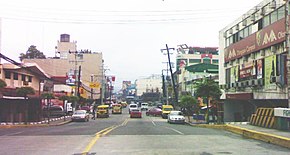Olongapo City
|
Olongapo City Lungsod ng Olongapo Syodad nin Olongapo |
||
| Location of Olongapo City in the Zambales Province | ||
|---|---|---|

|
||
| Basic data | ||
| Region : | Central Luzon | |
| Province : | Zambales | |
| Barangays : | 17th | |
| PSGC : | 037107000 | |
| Income class : | 1st income bracket | |
| Households : | 43.107 May 1, 2000 census
|
|
| Population : | 233.040 August 1, 2015 census
|
|
| Coordinates : | 14 ° 50 ′ N , 120 ° 17 ′ E | |
| Postal code : | 2200 | |
| Area code : | +63 47 | |
| Mayor : | Rolen C. Paulino | |
| Website: | www.olongapocity.gov.ph | |
| Geographical location in the Philippines | ||
|
|
||
Olongapo City ( Filipino : Lungsod ng Olongapo ; Sambal : Syodad nin Olongapo ) is a non-provincial Philippine city in the Central Luzon district . However, Olongapo City is assigned to the province of Zambales for statistical purposes .
Olongapo was originally administered as part of the United States Marine Reserve . On December 7, 1959, it was ceded to the Philippine government and converted into a municipality. Six years later, on June 1, 1966, Olongapo was converted into a chartered city . Olongapo City is managed autonomously by the Zambales Province. The city is bordered by the Subic Bay Freeport Zone, Zambales , which was also a marine reserve of the United States until 1992 (see United States Naval Base Subic Bay ). The Subic Watershed Forest Reserve is south of the free trade zone .
Surname
According to a famous legend, a group of warring tribes once existed in the area of what is now the modern city of Olongapo. A wise old man who recognized the dangers of disagreement managed to unite the warring tribes at great expense. However, he had opponents who bitterly revoked his idea and one day the man disappeared without a trace.
After a long search, the old man's body was found, but without a head. The tribesmen set up search parties to find the man's severed head. (It is also said to have been narrated that for the residents of Sambal, beheading was the only permissible form of execution. It was customary for the Sambal to kill those who took the life of another person, except when it was done by beheading. However, these efforts proved useless and the search was eventually abandoned. However, one boy did not want to stop looking until he found the elder's head. He searched for weeks and one day he found the elder's head stuck on a bamboo stick . When he saw the head, the boy ran “Olo nin apo! Olo nin apo! ”(Which means something like“ head of the elder ”in Sambal; translated from Tagalog as“ ulo ng apo ”) back to his people. He ran hysterically from village to village.
This is how Olongapo got its name. From that day on, the old man's head was a sign of the solidarity of the people in the modern city.
Barangays
The city of Olongapo is politically divided into 17 barangays :
|
|
Channel groups
- STV-6 : Channel 6
sons and daughters of the town
- Morris East (born 1973), boxer
- Eric Cray (* 1988), hurdler
- Jake Vargas (born 1992), actor
Web links
- Official website of Olongapo City (english, filipino)
- Subic Bay Freeport Zone - Tourism Site (English)
- Visit Subic Bay
- Subic Bay Directory & Real Estate (English)
- Tourism Information Subic Bay (English)
Individual evidence
- ↑ Olongapo City ( Memento from March 17, 2009 in the Internet Archive )


